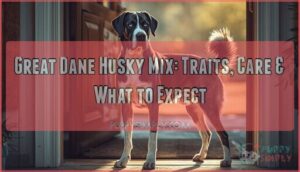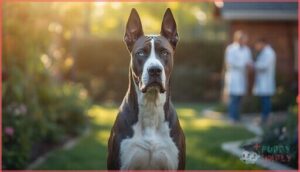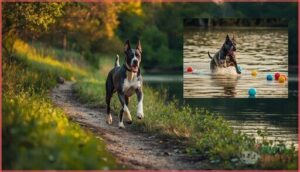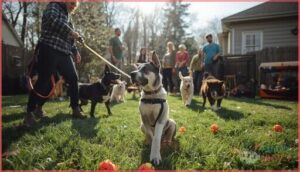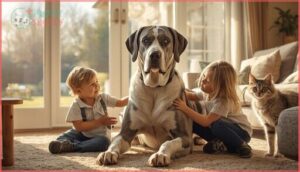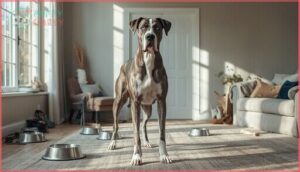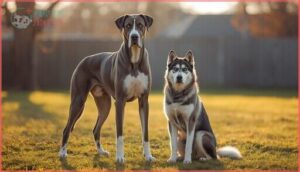This site is supported by our readers. We may earn a commission, at no cost to you, if you purchase through links.
A Great Dane husky mix stands at your door with the patience of a gentle giant and the mischievous sparkle of a sled dog—two extremes merged into one surprising package. This designer crossbreed pairs the towering, easy-going Great Dane with the high-octane Siberian Husky, creating a dog that can weigh up to 90 pounds yet still believes it belongs on your lap.
The result isn’t always predictable. You might get a laid-back companion who enjoys afternoon naps, or you could end up with an escape artist who needs constant mental challenges.
Understanding what shapes this mix—from its exercise demands to its health vulnerabilities—helps you decide if you’re ready for a dog that refuses to fit neatly into either parent breed’s mold.
Table Of Contents
Key Takeaways
- A Great Dane Husky mix is highly unpredictable in size, temperament, and energy level, requiring owners to prepare for anywhere from 60 to 90 pounds of either a laid-back companion or a high-energy escape artist.
- This crossbreed needs 1 to 2 hours of daily exercise and consistent mental stimulation to prevent destructive boredom, making it unsuitable for sedentary lifestyles or small living spaces.
- Health risks include bloat (a life-threatening emergency), hip dysplasia, bone cancer, and eye disorders, so routine vet care and awareness of symptoms are essential for longevity.
- Early socialization between 8 and 16 weeks is critical—exposing puppies to new people and dogs weekly reduces fear-based behaviors by up to 70% in adulthood.
Husky Great Dane Mix
The Great Dane Husky mix combines two powerhouse breeds into one striking family pet. This crossbreed emerged during the designer dog trend of the early 2000s, blending the Great Dane’s gentle patience with the Siberian Husky’s boundless energy.
Because both parent breeds differ so dramatically in size and temperament, expect significant unpredictability in your puppy’s final appearance and personality. Early puppy socialization is essential for raising a well-adjusted companion.
With proper training and consistent exercise, this mix becomes a loyal, playful addition to active households. They’re often used for guarding and hunting.
Appearance and Personality
Your Great Dane Husky mix will surprise you. Standing 24–28 inches tall and weighing 60–90 pounds, this dog blends both parents’ best traits. Coat variations range from short and smooth to thick double coats in colors like fawn, brindle, merle, or even harlequin. Eye color often includes striking blue or heterochromia—two different-colored eyes.
The temperament blend is equally impressive:
- Loyal and affectionate with family members
- Playful yet gentle, balancing Husky energy with Great Dane patience
- Independent but intelligent, making training both rewarding and challenging
Due to potential health concerns, owners should be aware of gastric dilatation-volvulus.
Health Problems
While this mix brings together two impressive breeds, you’ll need to stay alert about certain health risks. Hip dysplasia, affecting 15–30% of large breeds, makes joint issues a real concern for your dog. Bloat, the most dangerous condition, poses a serious GDV risk due to the deep-chested build, requiring emergency care.
Osteosarcoma, a bone cancer common in giant breeds, may necessitate aggressive treatment. Eye disorders like cataracts and progressive retinal atrophy can gradually impact vision. Thyroid problems, though less frequent, can cause weight changes and low energy if untreated.
Exercise Requirements
Beyond managing health concerns, your Great Dane Husky mix needs consistent physical activity to thrive. Adults require 1 to 2 hours of daily exercise—less than purebred Huskies but substantial nonetheless. Balance brisk walks with low-impact activities like swimming to protect growing joints.
Puppies follow the five-minute rule: five minutes per month of age until they’re fully grown. Don’t forget mental stimulation through puzzle toys and training sessions. This combination prevents boredom and keeps your dog both physically fit and mentally sharp.
Training Tips
Training your Great Dane Husky mix demands consistent positive reinforcement from day one. Start early socialization between 8 and 16 weeks—exposing puppies to 3 to 5 new people and dogs weekly reduces fear-based behaviors by up to 70% in adulthood. Use short 10- to 15-minute sessions with high-value rewards to maintain focus. Crate training builds security and prevents destructive habits. Master leash manners early, because adult Great Danes can exceed 150 pounds. Recall training in fenced areas before advancing to distracting environments keeps your mix safe and responsive.
Your training toolkit should include:
- Weekly puppy classes starting at 8 weeks to build confidence and obedience
- Front-attachment harnesses for better control during walks without neck strain
- Puzzle toys and trick training to satisfy your dog’s working drive
- Consistent household rules to prevent jumping and door-dashing before they become dangerous
- Daily mental stimulation through interactive games to curb boredom-related destruction
Grooming Needs
Your Great Dane Husky mix sheds continuously year-round, with heavier coat loss in late summer as the double coat transitions. Brush your dog twice weekly using a soft-bristle or rubber curry brush—daily sessions help during peak shedding.
Bathing should be limited to a few times yearly with moisturizing shampoo to prevent dry skin. Use wipe-downs between full baths. Trim nails monthly to prevent gait problems, clean ears routinely to stop wax buildup, and brush teeth regularly. Early habituation to grooming reduces stress as your pup grows into a 100-pound adult.
| Grooming Task | Frequency | Tools Needed |
|---|---|---|
| Brushing | 2x weekly (daily when shedding) | Soft-bristle brush, de-shedding tool |
| Bathing | Few times yearly | Moisturizing dog shampoo, wipes |
| Nail Trimming | Monthly | Dog nail clippers |
| Ear & Dental Care | Weekly check-ins | Ear cleaner, dog toothbrush |
Food Requirements
Your adult Great Dane Husky mix needs roughly 2,000 to 2,500 kilocalories daily, split across two meals to reduce bloat risk. Choose large-breed formulas with 23–30% protein and 12–20% fat, plus controlled calcium-to-phosphorus ratios between 1.1:1 and 1.4:1 for healthy bones.
Puppy nutrition demands three to four smaller portions with at least 22% protein. Add omega-3s from fish oil to support joints, and use slow-feed bowls to prevent rapid eating. Floor-level feeding is safer than raised stands for deep-chested dogs.
Temperament and Compatibility
Your Great Dane Husky mix temperament blends patience with playfulness, making family suitability strong when you prioritize early dog socialization. About 76% of Great Dane owners rate their dogs as excellent with children, and this Great Dane Husky Mix Personality often inherits that gentle nature.
The Great Dane Husky mix blends patience with playfulness, making it an excellent family dog when socialized early
Pet compatibility varies—most do well with other dogs through structured training, but the Husky’s prey drive can create challenges with small animals.
Lifestyle fit matters: you’ll need space, daily exercise, and commitment to overcome training challenges like stubbornness. This Great Dane Husky Mix Compatibility shines when you provide leadership, boundaries, and consistent positive reinforcement.
Things to Know Before Owning
Owning a Great Dane Husky mix before owning means accepting major lifestyle changes and a serious financial commitment. Expect $600 to $2,000 upfront, plus higher food and vet costs.
Space requirements are non-negotiable; you’ll need room for a dog reaching 90 to 190 pounds. Time commitment includes 60 to 120 minutes of daily exercise needs and ongoing training challenges.
Breed research reveals health risks like bloat and hip dysplasia, with lifespans around 8 to 12 years. This family pet thrives when you’re prepared for the full responsibility.
Male Vs Female
When choosing between a male or female Great Dane Husky mix, size differences are a key consideration. Males typically stand 1 to 3 inches taller and weigh 15 to 25 percent more, often reaching 100 to 130 pounds, while females usually weigh between 80 to 110 pounds.
Behavioral differences also play a role in the decision. Males tend to roam more and exhibit territorial marking, whereas females are generally calmer but can be protective. These variations influence training approaches; males may require firmer boundaries due to their independence, while females often respond more quickly to commands.
Health considerations remain relatively consistent between the sexes, although spayed females face a higher risk of urinary incontinence.
| Trait | Male | Female |
|---|---|---|
| Weight | 100–130 lbs | 80–110 lbs |
| Height | 26–33 inches | 24–30 inches |
| Behavior | More independent, territorial | Calmer, protective |
| Training | Needs firm leadership | Responds faster |
Frequently Asked Questions (FAQs)
What is the average lifespan of a Great Dane Husky mix?
Most Great Dane Husky mixes live between 8 and 12 years. Their lifespan reflects the Great Dane’s shorter longevity balanced with the Husky’s longer life expectancy, positioning them in the large breed range.
How much does a Great Dane Husky mix cost?
Puppy price tags shock most buyers—this giant mix often costs less than you’d expect. Breeders charge $600 to $2,000, while adoption fees through rescues run $100 to $500, covering initial veterinary care and setup costs for responsible pet ownership.
What is their average lifespan expectancy?
Most large breed dogs live 8 to 13 years, and this mix follows that pattern. Breed genetics and health risks like bloat matter most.
Good senior care and environmental factors can help your dog reach the upper end.
Are they good apartment dogs?
Space constraints and exercise needs make apartment life tough for this dog. Their size, noise levels, and high energy demand a dedicated owner lifestyle. With daily commitment, it’s possible but challenging.
Do they get along with other pets?
Dog socialization shapes how your Great Dane Husky mix reacts to other pets. Early socialization helps them coexist with dogs, but their prey drive makes cats and small animals risky without consistent training strategies.
Where can I find reputable breeders?
Finding a trustworthy breeder takes homework. Start with the Great Dane Club of America or Siberian Husky clubs for referrals. Always ask for health testing records and visit facilities before committing to your Great Dane Husky mix puppy.
Conclusion
This crossbreed is like a bridge between two worlds—one built for speed and independence, the other for calm companionship. Owning a Great Dane husky mix means committing to the unpredictability that comes with blending such different temperaments.
You’ll need patience, space, and energy to match theirs. But if you’re ready to meet their needs, you’ll gain a loyal companion who defies easy categorization and keeps life interesting.

